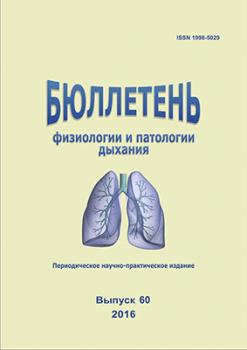Blagoveschensk, Blagoveshchensk, Russian Federation
Russian Federation
The aim of research is to investigate important structures in vivo of mucociliary conveyor of respiratory and airway parts of the lung of intact rats against general cooling by the method of scanning cryoelectron microscopy without fixation and dehydration. The rats (male) in an amount of 40 pieces were exposed to general cooling during 14 days for 3 hours per day at the temperature of -15ºC. Frozen in liquid nitrogen tracheal samples were placed on a freezing Pelzer table (-30ºC) of the consoles Deben Coolstage of scanning electron microscope Hitachi S-3400. The study was conducted at low vacuum (80Pa) using backscattered electrons detector (BSECOMP). It was found out that the epithelial lining of the trachea of rats is covered with a liquid layer consisting of viscous gel and aqueous phases masking ciliary epithelial cells. Mucous secretion of the bronchi is presented by single plates with mucus cellular elements. On the alveolar surface in the monolayer of surfactant there were discovered globular clusters of lattice surfactant. With total cooling on the surface of epithelial layer the amount of bronchial secretions increases, the structure of the mucociliary apparatus changes and tracheal mucosa surface becomes wavy and there are sometimes marked accumulations of mucus. In the epithelial lining there are identified areas with the predominance of ciliated epithelium goblet cells lacking microvilli. The secretory activity of goblet cells and type 2 alveolocytes of respiratory department is accompanied by an increased release of secretion causing a disturbance of mucociliary transport.
scanning cryo-electron microscopy, lungs, total body cooling, animals.
1. Alberts B. Bray D., Lewis J., Raff M., Roberts K., Watson D. Molecular Biology of the Cell. Moscow: Mir; 1994 (in Russian).
2. Goldstein J., Newbury D., Echlin P., Joy D., Fiori C., Lifshin E. Scanning electron microscopy and X-ray microanalysis. Vol.2. Moscow: Mir; 1984 (in Russian).
3. Belous A.M., Bondarenko V.A. Cryodestruction biomembranes. Structural and functional abnormalities of mitochondria and lysosomes. In: Pushkar N. S., Belous A. M., editors. Actual Problems of Cryobiology. Kiev: Naukova Dumka; 1981: 41-88 (in Russian).
4. Belous A.M. Bondarenko V.A. Mechanisms of development of cold damage cell membranes. In: Cryobiology and cryomedicine. Kiev: Naukova dumka; 1981: 3-17 (in Russian).
5. Borovyagin V.L. Methods of ultrathin sections, negative contrast, and chipping in the research model and ultrastructural organization of cell membranes. Uspekhi sovremennoy biologii 1974; 77(3):399-421 (in Russian).
6. Kaprelyants A.C. Electron microscopic examination cooled to -196ºC erythrocytes. In: Cryogenic methods of electron microscopy. Pushchino; 1977: 44-45 (in Russian).
7. Kirillov V.A., Konev C.B. Change the orientation of the cleavage plane of cell membranes using the method of freeze-fracture as an indicator of changes membrane structure. Tsitologiya 1984; 16(5):521-525 (in Russian).
8. Kuz´minykh S.B., Allakhverdiev B.L., Hutsyan S.S. Problems of development and equipment cryotechniques. In: Cryogenic methods of electron microscopy. Pushchino; 1977: 101-107 (in Russian).
9. Lozina-Lozinsky L.K. Essays on Cryobiology. Leningrad: Nauka; 1972 (in Russian).
10. Landyshev Y.S., Dorovskich V.A., Tseluyko S.S., Lazutkina E.L., Tkachevа S.I., Chaplenko T.N. Bronchial asthma. Blagoveshchensk; 2010 (in Russian).
11. Radyuk M.S. Re-condensation of water vapor as the cause of the artifacts in the study of membrane chips, obtained by freeze-fracture. Tsitologiya 1982; 24(1):115-116 (in Russian).
12. Repin N.V., Skornyakov B.A. Methodical features and technical support for electron microscopy method of freeze-fracture In: Cryobiology and cryomedicine: republican interdepartmental collection. Kiev: Naukova dumka; 1982: 89-92 (in Russian).
13. Tseluyko S.S., Dorovskich V.A., Krasavina N.P. Morphological characteristics of the connective tissue of the respiratory system with a total cooling. Blagoveshchensk; 2000 (in Russian).
14. Tseluyko S.S., Semenov D.A., Perelman J.M., Odireev A.N. Morphofunctional characteristic of mucus-producing components in rat’s airways under osmotic stress. Bûlleten´ fiziologii i patologii dyhaniâ 2015; 57:70-76 (in Russian).
15. Tseluyko S.S., Zinoviev S.V., Gorbunov M.M., Reshodko D.P. Scanning electron microscopy cryogenic objects lungs of rats at cold exposure. Amurskiy meditsinskiy zhurnal 2016; 2:47-51 (in Russian).
16. Adams G.D.J. Freeze-drying of biological materials. Drying technology 1991; 9(4):891-923.
17. Barresi A.A., Fissore D., Pisano R. Freeze-drying techniques. New ways to enhance process control and recipe development in pharmaceuticals freeze-drying. Pharm. Manuf. Packing Sourcer 2009; 43(5):36-42.
18. Barresi A.A., Ghio S., Fissore D., Pisano R. Freeze-drying of pharmaceutical excipients close to collapse temperature: influence of the process conditions on process time and product quality. Drying Technol. 2009; 27(6):805-816.
19. Collins S.P., Pope R.K., Scheetz R.W., Ray R.I., Wagner P.A., Little B.J. Advantages of environmental scanning electron microscopy in studies of microorganisms. Microsc. Res. Tech. 1993; 25(5-6):398-405.
20. Franks F., Auffret T. Freeze-drying of Pharmaceuticals and Biopharmaceuticals. Cambridge: Royal Society of Chemistry; 2007.
21. Hottot A., Andrieu J., Vessot S., Shalaev E., Gatlin L. A., Ricketts S. Experimental study and modeling of freeze-drying in syringe configuration. Part I: freezing step. Drying Technol. 2009; 27(1):40-48.
22. Nail S.L., Jiang S., Chongprasert S., Knopp SA. Fundamentals of freeze-drying. Pharm. Biotechnol. 2002; 14:281-360.
23. Rey L. Potential prospects in freeze-drying In: Rey L., May J.C., editors. Freeze-Drying/Lyophilization of Pharmaceutical and Biological Products. New York: Marcel Dekker Inc.; 1999: 465-471.
24. Severs N.J. Freeze-facture electron microscopy. Nat. protoc. 2007; 2(3):547-576.





